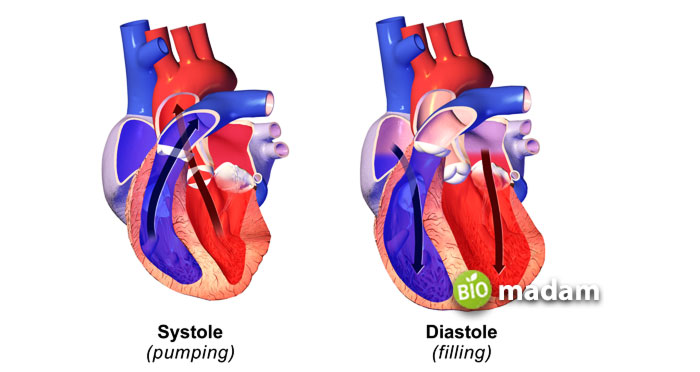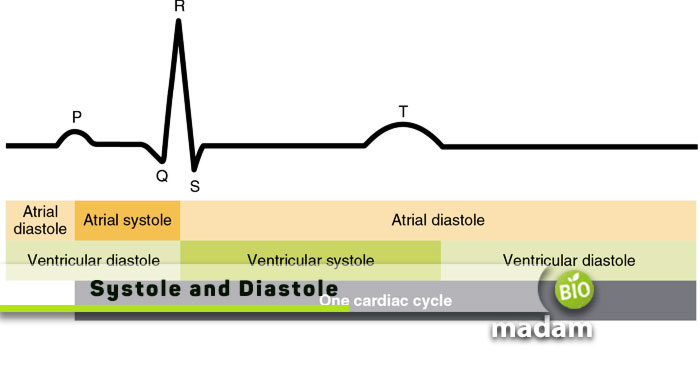Recently updated on March 7th, 2023 at 07:56 am
The terms systolic and diastolic are commonly used when talking about blood pressure. They refer to the flow of blood in blood vessels, specifically arteries. Never confuse the flow of blood in arteries with the flow in veins and capillaries when discussing systolic or diastolic pressure. The pressure in the vessels varies when the heart pumps blood to different body parts. Systolic blood pressure is produced by the heart, while diastolic pressure generates between heartbeats. The main difference between systolic and diastolic blood pressure is that systolic is the highest pressure in the arteries, whereas diastolic is the lowest.
Keep reading to learn all the differences between systolic and diastolic blood pressure.
Comparison Table
| Characteristic | Systolic | Diastolic |
| Definition | Blood pressure during heartbeats | Blood pressure between heartbeats |
| Literal Meaning | Drawing together | Drawing apart |
| Range of Blood Pressure | Maximum | Minimum |
| Mechanism | Left ventricle contraction | Left ventricle relaxation |
| Normal Range | 90 – 120 mm Hg | 80 – 110 mm Hg |
| Change with Age | Increases | Decreases |
What is Systolic Blood Pressure?
Systolic blood pressure refers to the highest arterial pressure in your body. The arteries experience maximum pressure when the left ventricle in the heart contracts. The phase of the active heartbeat is known as the systole and helps eject the blood out of the heart. This blood then moves to different tissues and organs of the body to supply oxygen, micro and macronutrients. The ejection of blood to the aorta builds pressure in the arterial walls comprising epithelial and connective tissue. This pressure gives rise to systolic blood pressure.
The systolic pressure in a healthy adult is between 90-120 mm Hg on rest. It may increase after exercise or if you suffer from heart disease.
What is Diastolic Blood Pressure?
Diastolic blood pressure is the lowest or minimum pressure of blood in the arteries. Opposed to systole, it takes place between heartbeats. When the heart’s left ventricle relaxes, the pressure falls, and blood fills the heart.
The normal diastolic pressure in a healthy adult is from 60 to 80 mm. Diseases or any disorder condition may also elevate diastolic blood pressure besides systolic. A diastolic blood pressure above 110 mmHg is considered dangerously high, whereas below 60 mm Hg is critically low. It may result from severe bleeding or dehydration, so one should drink sufficient glasses of water a day, especially people with hypertensive disorders.
Similarities Between Systolic and Diastolic
- Systolic and diastolic represent the blood pressure generated when the heart receives or pumps blood.
- They determine the pressure of blood in the arteries.
- Females typically exhibit lower systolic and diastolic blood pressure.
- A continuous increase or decrease in systole or diastole may represent disease conditions.

Difference Between Systolic and Diastolic
Definition
Systolic
Systolic blood pressure is the pressure exerted by blood on the arterial walls when the heart is actively beating.
Diastolic
On the other hand, diastolic blood pressure refers to the pressure on the walls of arteries between heartbeats.
Origin
Systolic
The word systole is adapted from Greek and translates to a contraction or ‘drawing together.’
Diastolic
Similarly, diastole also belongs to the Greek language, meaning ‘drawing apart.’
Range of Blood Pressure
Systolic
Systolic is the maximum blood pressure recorded in the arteries. It is typically present in large arteries.
Diastolic
Diastolic blood pressure, in contrast, is the minimum or lowest blood pressure in the large arteries.
Occurrence
Systolic
The systolic pressure rises in the systolic stage of the cardiac cycle.
Diastolic
On the other hand, the diastolic pressure is recorded during the diastolic phase of the cardiac cycle.
Mechanism
Systolic
The contraction of the left ventricle of the heart to push blood to the aorta gives rise to systolic blood pressure.
Diastolic
On the other hand, diastolic blood pressure results from the arterial muscles’ relaxation when the heart’s left ventricle relaxes and fills blood.
Normal Range
Systolic
The normal systolic blood pressure range in a healthy individual lies between 90 and 120 mm Hg.
Diastolic
Whereas a normal healthy human has a diastolic blood pressure between 80 and 110 mm Hg.
Changes with Age
Systolic
The systolic pressure usually increases with the increase in age as you might have seen older people with a high systolic pressure.
Diastolic
Just like that, people often experience an increase in their diastolic blood pressure as they grow old. So, systolic and diastolic together makes a person hypertensive.
Significance of Systolic and Diastolic Blood Pressure
Systolic and diastolic blood pressures explain the blood pressure in the body altogether. They are of critical importance, and fluctuations may exhibit an underlying disease. Systolic blood pressure is critical and may signal issues such as cardiovascular diseases. In such situations, the arteries experience a higher pressure leading to hypertension or high blood pressure. On the other hand, diastolic pressure may indicate the blood flow to the heart. A low diastolic pressure results from a low coronary artery pressure. This condition, due to lack of oxygen and blood, is known as ischemia and may lead to heart failure if unattended.
The Bottom Line
Systolic and diastolic blood pressures are critical to the human body to ensure proper physiological functioning. Systolic is the maximum blood pressure, while diastolic is the lowest blood pressure in the arteries. The primary difference between systolic and diastolic, leading to changes in pressure, are the phases of the cardiac cycle. The systolic blood pressure rises as a result of the contraction of the heart and the pushing of the blood to the aorta. Alternatively, heart muscle relaxation to fill blood causes diastolic pressure.
FAQs
Which is more important blood pressure systolic or diastolic?
Systolic and diastolic blood pressures both are vital to life. However, systolic blood pressure allows healthcare workers to understand heart conditions better. High systolic blood pressure is the basic indication of hypertension and can initially be heard with stethoscope.
What does a large gap between systolic and diastolic mean?
A large gap between systolic and diastolic blood pressure is also known as wide pulse pressure. It indicates the sedentary lifestyle of individuals who are not physically active.
What is high blood pressure?
As the name indicates, high blood pressure means your arterial pressure is higher than 80 mm Hg to 120 mm Hg. 120 mm Hg to 129 mm Hg is considered elevated blood pressure. Blood pressure >130 mm Hg is hypertension stage 1, while > 140 mm Hg is hypertension stage 2.

Anna has completed her degree in Pharmacy from the University of Hawaii. She is serving as a research assistant in a pharmaceutical company. She had a great interest in writing blogs, traveling to different parts of the US, and trying delicious recipes in her spare time.

